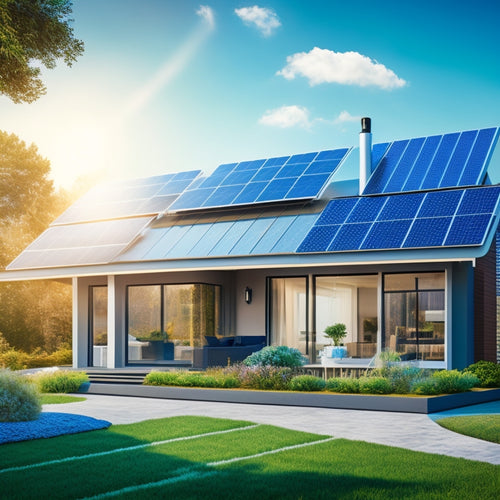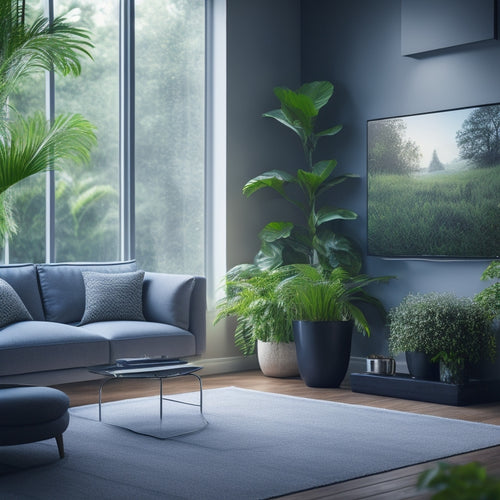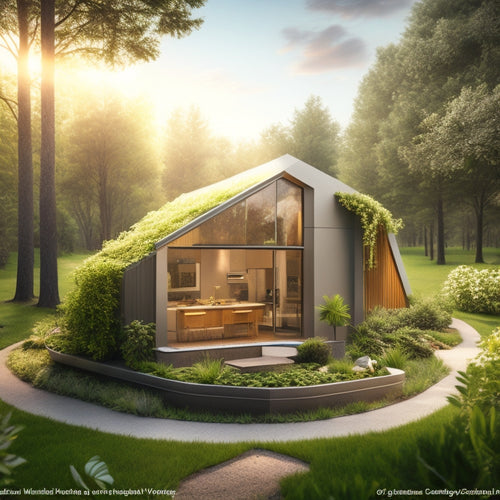
Transform Your Home: Clean Air Meets Energy Efficiency
Share
You're about to uncover a groundbreaking approach to creating a healthier, more energy-efficient home by integrating clean air and sustainable energy solutions that not only improve indoor air quality but also reduce your carbon footprint. By incorporating natural ventilation, renewable energy sources, and smart air purification systems, you can create a healthier indoor climate while minimizing energy waste. Indoor plants, heat recovery technology, and optimized ventilation systems can also play an essential role in achieving this balance. As you investigate these innovative strategies, you'll reveal an extensive approach to changing your home into a haven of clean air and energy efficiency, and that's just the beginning.
Key Takeaways
- Combine natural ventilation and heat recovery technology for energy-efficient air quality management.
- Install advanced air purification systems that capture 99.97% of particles as small as 0.3 microns.
- Incorporate indoor plants to naturally purify air and regulate humidity levels.
- Optimize ventilation systems with sensors and humidistats to maintain a healthy indoor climate.
- Upgrade to renewable energy sources and energy-efficient solutions to reduce carbon footprint and energy costs.
Sustainable Air Quality Management
Your community's air quality is a critical component of public health, and sustainable air quality management is essential to mitigate the adverse effects of air pollution.
You can take control of the air you breathe by implementing simple yet effective strategies in your home. One approach is to integrate indoor plants, which are natural air purifiers, into your living space. These plants absorb pollutants, such as volatile organic compounds and particulate matter, improving indoor air quality. By incorporating air-purifying plants, you're taking a proactive step towards creating a healthier environment.
Moreover, maintaining a well-ventilated home and reducing indoor pollution sources, such as strong chemicals, can additionally enhance air quality.
In addition, adopting renewable energy solutions, like solar panels or biodiesel fuel systems, can reduce your carbon footprint and contribute to a cleaner environment.
Energy-Efficient Ventilation Systems
By reducing indoor pollution sources and adopting renewable energy solutions, you've taken significant steps towards creating a healthier environment.
Now, it's time to optimize your ventilation system to maximize energy efficiency. Energy-efficient ventilation systems utilize natural ventilation and incorporate heat recovery technology to minimize energy losses, much like how hydroelectric power plants generate substantial electricity for EV charging.
This allows you to breathe easy while keeping your energy bills in check. Heat recovery systems capture heat from exhaust air and transfer it to fresh air, reducing the energy required to heat or cool your home.
Smart Air Purification Solutions
Incorporating smart air purification solutions into your indoor space is an essential step towards achieving ideal air quality, as they work in tandem with your energy-efficient ventilation system to remove pollutants and allergens from the air.
You can opt for smart filters that capture 99.97% of particles as small as 0.3 microns, including dust, pollen, and smoke. Additionally, incorporating renewable energy sources, such as solar energy, can further reduce your carbon footprint and enhance energy independence.
By investing in energy-efficient solutions, you'll not only breathe easier but also contribute to a sustainable future. Alternatively, portable purifiers can be placed in specific areas, such as bedrooms or living rooms, to provide targeted air cleaning.
These solutions are designed to work efficiently, using advanced sensors to detect pollutants and adjust their cleaning cycle accordingly. By investing in smart air purification solutions, you'll breathe easier, knowing your home's air is clean and fresh.
Clean Air Circulation Strategies
Effective air circulation is key to maintaining ideal indoor air quality. You can achieve this by implementing strategies that promote natural airflow and remove stale air from your home. Here's a breakdown of effective clean air circulation strategies:
| Strategy | Benefits | Implementation Tips |
|---|---|---|
| Open Windows | Introduces fresh air, reduces stagnation | Open windows on opposite sides of the home for 10-15 minutes daily |
| Use Fans | Circulates air, improves ventilation | Position fans to push air towards open windows or doors |
| Install Vents | Removes stale air, improves air exchange | Install vents in areas with high humidity, such as bathrooms and kitchens |
| Add Indoor Plants | Purifies air, improves air quality | Choose low-maintenance plants like peace lilies or spider plants |
| Upgrade Insulation | Reduces air leaks, improves circulation | Insulate walls, floors, and ceilings to prevent air escape |
Healthy Indoor Climate Control
Your thermostat is the commander of your indoor climate, regulating the temperature and humidity levels to create a comfortable living space.
However, humidity regulation is often overlooked, leading to mold growth and respiratory issues. To maintain a healthy indoor climate, it's crucial to control humidity levels between 30-50%.
With the integration of solar-powered solutions, you can reduce your carbon footprint and energy costs while optimizing your humidity regulation. You can achieve this by using a humidistat, which works in tandem with your thermostat to monitor and adjust humidity levels.
Additionally, incorporating indoor plants like peace lilies or spider plants can help purify the air and regulate humidity naturally.
Frequently Asked Questions
How Often Should I Replace Air Filters in My Home?
You should replace air filters every 1-3 months, depending on filter types and usage. Create a replacement schedule based on your home's specific needs, considering factors like pets, allergies, and HVAC system type to guarantee ideal air quality and system efficiency.
Can I Use Plants to Purify the Air in My Home?
Imagine being in a dense forest, surrounded by fresh oxygen - that's what you can achieve indoors! Yes, you can use plants to purify the air in your home, with some indoor plants removing up to 90% of air pollutants, greatly improving air quality.
Are Energy-Efficient Appliances Worth the Extra Cost?
You'll find that energy-efficient appliances are worth the extra cost, as they provide long-term savings on your utility bills and reduce your environmental impact, giving you financial freedom and a clearer conscience.
Do Air Purifiers Really Eliminate All Indoor Pollutants?
You're wondering if air purifiers really eliminate all indoor pollutants. The answer is, they can greatly improve air quality by capturing various pollutant types, including particulate matter, volatile organic compounds, and gases, but may not remove all pollutants, depending on the specific model and settings.
Can I Install Energy-Efficient Systems Myself or Hire a Pro?
You're considering DIY installation of energy-efficient systems, but don't know if you're up for the task; while it's possible, complex projects often require professional assistance to guarantee safety, efficiency, and warranty validity.
Related Posts
-

7 Best Cool Roof Rebates for Energy-Savvy Homeowners
You're an energy-savvy homeowner looking to install a cool roof, and you're wondering which rebates can help you save...
-

7 Best Home Hydrogen Fuel Cells for Clean Power
You're considering adopting hydrogen fuel cells for clean power at home, but you want to know the best options. Reput...
-

10 Best Sustainable Waste Management Solutions for Green Homes
You're likely unaware that the average green home generates over 2 kilograms of waste daily, but with the right susta...


